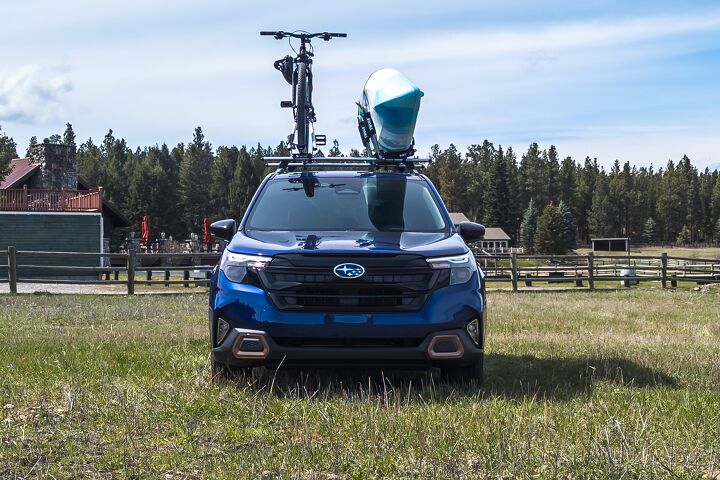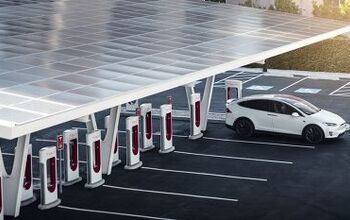2025 Subaru Forester Review – Just A Little More-ester

The Subaru Forester is new for 2025. But the majority of changes aren’t the type you’d see with a totally new, ground-up model. Yes, the body is new, but Subaru has honed the Forester edge rather than totally re-forging the SUV. Frankly, I think that’s a good thing. The Forester doesn’t need major changes – it’s already a pretty darn good Point A-to-Point B machine. The changes by and large make it an even more appealing machine – and one that’s good for some off-road work, too.
These changes are largely concentrated on a handful of items: Bringing the Forester up to date with other models in the lineup from a technological standpoint, updating the model aesthetically, and making it quieter. Subaru has made massive strides on those last two points thanks to, as we were told, more structural adhesive than even the uber-luxurious-and-capable Lexus GX (though starting a build quality war with Lexus may not be such a smart move). Regardless, the latest Forester will also become more efficient and more rugged when its hybrid and Wilderness variants come on sale. We were told both will be coming soon, but Wilderness buyers will have to settle for the existing ‘24 Wilderness model for the moment.
Disclosure: Subaru flew me out to a palatial cabin near Missoula, Montana to experience the new Forester, as well as some very good locally-made whiskey, some truly Big Skies, and some much-needed quality time with the only two creatures that truly understand me: A dog named Aida owned by Subaru PR and other self-loathing journalists. I won’t be keeping the very nice jacket Subaru handed me at check-in, as I’ve already got around 50 I don’t use.
Looking at the new Forester, it’s easy to see things are different this time around. Much of the new looks come courtesy of front and rear bumper redesigns, which totally reinvent the looks.
The front is now much smoother, with a much narrower lighting profile and a new wider grille. Sport trims get their own special bronze accenting throughout. The latest Forester also keeps one of the best things about the outgoing model – the greenhouse. Subaru has actually expanded the rear quarter glass, and visibility is all the better for it. In back, the bumper also adds a sleeker, more modern look to the Forester.
Dimensionally, it’s impossible to tell the new model from the outgoing – a good thing in a world of bloated cars that have grown far too much over the last 20 years. Per Subie, the latest and greatest Forester is just 0.6 inches longer and 0.5 inches wider. As a result, cargo space doesn’t change much, which is good, since I feel it’s more than enough. On the Subaru Crosstrek Wilderness program, I was told a lot of Subaru owners fit a roof rack of some variety to haul larger items, anyway.
Inside, you’re greeted by new seats. These held up well over a few hundred miles of on and off-road driving, thanks in large part to lumbar adjustment and new bolsters. The bolstering was a direct result of customer feedback, apparently, and it does help off-road. Sport models now also feature the same Startex seating surfaces as Wilderness models. Two screen options are on offer here – a pair of dual 7-inch screens for base models and Subaru’s single tablet-style screen measuring 11.6 inches. This screen is identical to the one found in models like the Crosstrek and WRX (which donates a modified version of its steering rack to the new Forester). It works well, but we miss physical climate controls, and the resolution is lower than that of competitors. But, Limited models do get a handy 360-degree camera that can be had as an option further down the trim ladder.
Let’s talk about money. Apparently, the Forester’s $31,090 base price doesn’t matter much, as practically no one gets the base model car. Instead, most people end up with the Premium or higher, which starts at $33,390 and is followed by the Sport ($35,890), the Limited ($37,390), and the range-topping Touring model ($41,390).
Regardless of trim, this latest Forester still uses a 2.5-liter, naturally-aspirated four-cylinder engine paired to standard AWD and a continuously-variable automatic transmission (CVT). It makes 180 horsepower and 178 pound-feet of torque and serves as our segue into the driving dynamics.
Those numbers are enough – at least until it’s time to overtake a semi on a two-lane Montana highway with a 75-mph speed limit. I’d love it if the Forester packed a little more torque. But Subaru says the engine has changed, despite its output being nearly identical to last year’s model. Many parts have simply been honed or made lighter, with updates intended to ensure the engine’s longevity rather than increase performance. However, we were told by Subaru folk that the torque curve is a little fatter, but the Forester still needs a torque figure that starts with a “2” in my opinion.
The bread and butter of the Forester driving experience is centered around its greatly refined manners on road. At 80 mph, there’s hardly a hint of wind noise, and I find the new car quieter than other models. We rode in an Outback Wilderness on the way to the airport, and it seemed louder at roughly the same speeds. The ride is much improved too, and the Forester manages to be cushy without being floppy. Whether the “more structural adhesive than a Lexus” line really matters is up for debate, but at the very least, the benefits in comfort and body rigidity are plain to see.
The Forester holds up well off-road too, despite the lack of a 2025 Wilderness model for now. Our Limited-trim Forester benefitted from the same X-Mode AWD settings found in said Wilderness, and these really do make an impact, depending on the current terrain. Buyers will be happy to hear the software is available on more of the lineup than ever, which will make a real difference in the SUV’s off-road capabilities. However, without proper tires, extremely loose surfaces like deep snow or mud quickly overwhelm the Forester. This is where the Wilderness trim becomes necessary for those spending a lot of time off-road.
It’s nice to drive something without the need for it to be sporty in some way – so many other vehicles fall into this trap. Despite the Forester’s trim of the same name, there isn’t a sporting bone in the SUV’s body. Sure, I’d love it if the AWD system fed more power to the rear in some circumstances, as the gobs of understeer are, to put it lightly, undesirable. And yes, a touch more torque would be nice to have. But having a car that’ll do everything at a competitive price point with the cost of all-wheel drive baked in is surely appealing. It’s hard to imagine the new Forester will be anything but to consumers, and I’m excited to see how the hybrid and Wilderness models improve on the foundation laid down by this latest generation.
[Images © 2024 Chase Bierenkoven/TTAC.com]
Become a TTAC insider. Get the latest news, features, TTAC takes, and everything else that gets to the truth about cars first by subscribing to our newsletter.

Chase Bierenkoven has been writing about cars in his head since he was a child. Now, he does it for real, covering automotive news and producing reviews for outlets like Edmunds, Forbes Wheels and CarBuzz. Chase's career as an automotive journalist began in 2020, and he has already written scores of road tests. Some favorites of Chase's include the Dodge Challenger 392, Mazda Miata, Kia EV6 and Bentley Bentayga. Outside his work with cars, Chase is often found justifying his latest broken German sports car to anyone that will listen or enjoying the outdoor spaces of his native Colorado.
More by Chase Bierenkoven
Latest Car Reviews
Read moreLatest Product Reviews
Read moreRecent Comments
- KevinB Hemmings ran an article on the 1960 Cadillac Series 62 grille and its complexity. It took a lot of work.https://www.hemmings.com/stories/article/1960-cadillac-series-62
- Kwik_Shift_Pro4X Now going for $7000.
- SCE to AUX Working on a deck project. Also replaced the A/C compressor in a Subaru.
- A I have a project 87 or 88, don't have the year in front of me. Tranny was starting to slip when my daughter drove it, original tranny so it's likely the rubber seals are failing. I had a backup tranny so i disassembled it to see what kind of shape it was in. I did see it needs all the rubber seals, hard parts are all good. So a basic rebuild kit should fix it. The reason she stopped driving it was because she heard a slight engine knock. So both engine and tranny likely will need a rebuild. We are from Wisconsin but only rarely driven in snow, underside looks solid and a bit of surface rust here and there. Some fading from the sun.She has decided to let it go now that ahe is a mother and no air bags. This car is fun to drive but at my age i don't need another project. Will send pictures if anyone is interested, I will let it go at junk price, just would rather see it fixed and driven then crushed and melted down.Contact info thewoz69@gmail.com
- A Contact info thewoz69@gmail.com









































Comments
Join the conversation
The ugly stick has gotten bigger.
"...the latest and greatest Forester is just 0.6 inches longer and 0.5 inches wider."
This is especially useful because everybody, everywhere had memorized the dimensions of the previous model and can quickly do the math.
TTAC is far from the only car source who writes like this, but damn, would it kill you to include the actual dimensions?